Midwifery is defined as the “skilled, knowledgeable, and compassionate care for childbearing women, newborn infants, and families across the continuum from prepregnancy, pregnancy, birth, postpartum, and the early weeks of life.”
Evidence shows that midwifery, when provided by an educated, trained, and licensed midwife, is associated with improved quality of care and reduced maternal and newborn mortality.
Whether you’re considering becoming a midwife through a DNP midwifery program or you’re planning a family, it’s essential to understand the importance of a midwife. They play an important role in family planning and providing support before conception to postnatal.
This article will explore the profession and its role in reducing maternal and newborn mortality rates—which America is currently facing a crisis with. Data has found 80% of maternal deaths are preventable with the right care, provided through a midwife.
The vital role of midwives
Midwives are healthcare providers that specialize in pregnancy, childbirth, newborn care, and postpartum health. Depending on where they work and their credentials, midwives can provide a range of health services, including (but not limited to):
- Attending to birth and newborn care
- Postpartum care (immediately after childbirth and generally 6-8 weeks later)
- Pap tests and breast exams
- Education on nutrition, fertility, and other aspects of reproductive health
- Providing advice and/or counseling for family planning
- Ultrasounds and prenatal blood work
A midwife can practice at hospitals, clinics, birth centers, or a patient’s home. In the United States, there are also different types of midwives based on their certifications. These include:
- Certified nurse midwives (CNMs) are midwives who have completed nursing school and chosen to pursue a graduate degree in midwifery.
- Certified midwives (CMs) are professionals who have a master’s degree in midwifery but have not completed nursing school. They are only licensed to practice in certain states.
- Certified professional midwives (CPMs) work in birth centers or homes. They have only completed coursework (no Master’s or nursing school) and are certified by the North American Registry of Midwives.
The differences between the types of midwives lie in their education, qualifications, and scope of care. For example, a CNM can prescribe medication and work in all 50 states, whereas a CPM can’t provide the same level of care, and can only practice in a few states.
The healthcare workforce shortage
The United States is experiencing a healthcare workforce shortage, which has been exacerbated by the pandemic. This shortage impacts almost every facet of healthcare, from practitioners to nurses, including midwives.
According to a study from the American College of Nurse-Midwives, there are only 14,000 midwives in the US, including those not in clinical practice. This means there are currently only 4 midwives employed per 1,000 live births.
The statistics get more concerning, too. With the US facing over 3.7 million live births a year, at least 22,000 midwives are needed in the midwifery workforce to meet the World Health Organization’s (WHO) goal of a minimum of 6 per 1,000 live births.
There would need to be at least 8,200 more midwives employed to meet the WHO’s goal, which is a massive concern. This data reveals that most people in the United States do not have access to midwives, which is vital for reducing maternal and newborn mortality.
Even if the United States were able to reach the WHO’s minimum (6 midwives per 1,000 live births), its midwifery workforce would still be behind every other high-income country. Statistics show the United States has the lowest overall supply of midwives and OB-GYNs compared to other developed countries.
America’s maternal mortality crisis
In addition to the midwife shortage, the US is also facing a maternal mortality crisis. In 2022, the country’s maternal mortality rate was 22 deaths for every 100,000 live births. A total of 817 women died that year in the US due to maternity-related causes.
The United States has the highest rate of maternal deaths of any high-income nation, despite a decline since the COVID-19 pandemic. Data reveals the rate of maternity-related deaths is also highest for Black women, suggesting race and class also have an impact.
Nearly two of three maternal deaths in the US occur during the postpartum period—meaning up to 42 days following birth. Studies comparing women in the US to other countries have found this could be due to the lack of postpartum supports, like home visits and guaranteed paid leave.
Where most high-income countries have managed to improve mortality rates and care over the years, the US has only worsened. US maternal mortality rates more than doubled between 1987 and 2018 and are expected to grow in the future.
The link to midwives
The maternal mortality crisis the United States is currently facing can be linked to the midwifery shortage. One of the major factors impacting the maternal mortality crisis is the lack of access to healthcare services, particularly during the postpartum period.
According to the World Health Organization, 80% of all maternal deaths, stillbirths, and neonatal deaths could be avoided by employing more midwives. They play a crucial role in providing care from before conception to well after birth to ensure the health of the mother and babies.
Statistics show that the US currently has a shortage of midwives, and also that OB-GYNs outnumber them. In other countries, like the UK and the Netherlands—which have better mortality rates—midwives outnumber OB-GYNs and perform most prenatal care and deliveries.
In other developed countries, like the Netherlands, France, and Germany, midwives provide postpartum care/home visits and are covered by national insurance. In the US, however, it’s rarely a midwife providing postpartum care, and it is only covered in some state Medicaid programs and certain health plans.
Aiding the mortality crisis
There is a clear link between America’s maternal mortality crisis and midwives. While the problem will require a multi-faceted solution, growing the midwifery workforce and improving accessibility to postpartum care provided by midwives is a great start.
The midwifery workforce needs to almost double in size over the next few years to meet the World Health Organization’s standards. They could do this by improving the current work conditions to better retain employees and make midwifery a more attractive job prospect, through increasing salaries and benefits.
Improving accessibility to postpartum care provided by midwives will require fundamental changes to the United States healthcare system. The US Government will need to invest in better public health systems if they want to improve the crisis, they will also need to work on bridging the gap that exists in the healthcare system for people from diverse/minority groups.
Healthcare is also in dire straits in rural parts of the United States, especially for midwifery. More than half of rural hospitals in the US reported no locally available midwifery care options.
This is a major issue in an already growing problem of a shortage of healthcare providers in rural areas. The US Government needs to recognize the importance of midwifery and invest in its workforce if it wants to improve maternal mortality rates.























